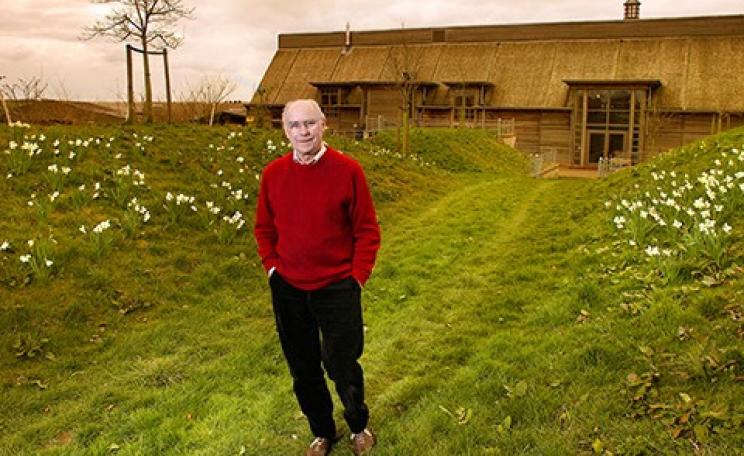When you think of gold, what do you see? A bling ring or gold bars in the bank? Perhaps a golden opportunity or a golden future? Gold has long enjoyed a reputation as the most precious and valuable of metals, a symbol of wealth, status – marital and financial – and general good fortune. Yet behind its golden image lies a murky past. This non-essential, very expensive, luxury product is 100 per cent dependent on one of the most socially and environmentally exploitative industries in the world.
‘I would say, per unit of output, that gold mining may well be the most destructive industry,’ says Payal Sampay, a director of the NoDirtyGold campaign launched by Oxfam. ‘To make one 0.33oz wedding ring generates on average 20 tonnes of mine wastes. Gold mining today has a giant ecological footprint.’
A dirty business
Two-thirds of newly mined gold is extracted from immense open-pit mines, some of which can even be seen from outer space. Destructive and dangerous, these mines are an environmental disaster. They pollute the air, earth and water, and leave in their wake huge piles of waste rock (some of them the height of a 30-storey building), which leach toxic metals and acid. Mine waste has turned groundwater thousands of times more acidic than battery acid. Toxic nasties used include sulphuric acid, which can pollute the environment and water supplies for centuries; cyanide, used to make the gold leach out of the ore, which is highly toxic to people and wildlife – a dose the size of a grain of rice can be fatal; and mercury.
The aftermath of large-scale mining is a contaminated landscape of devastation. Yet in many developing countries, the companies that have enriched themselves through this destruction are not held accountable for mitigating it. Profits are reaped by investors overseas and central government, rather than the communities that have to bear the true costs of mining – environmental damage and pollution, loss of traditional livelihoods and deteriorating public health. Mining has also been linked to human rights abuses and forced displacement – between 1995 and 2015, approximately half the gold produced worldwide has or will come from indigenous people’s lands. Small-scale mines have their own set of problems, including mercury pollution and using children as miners, which the Internatinoal Labour Organization calls one of the ‘worst forms of child labour’.
So what can be done? ‘Gold production and producers need to be regulated and held accountable for the true impact and cost of goldproduction,’ says Stephanie Roth, a former Ecologist journalist who helped set up a campaign to stop a 13-million-tonne gold mine being dug in Rosia Montana, rural Romania (go to www.banktrack.org and click on ‘dodgy deals’). She is involved in a coalition of several Romanian NGOs that are pressing for a cyanide ban in Romania (www.bancyanide.ro). If the proposed cyanide bill becomes law it could stop the mine being built – and become a precedent that could be copied by other countries.
‘Miners always get away with and profit from unregulated destruction,’ says Stephanie. ‘If no changes occur, more and more remote forests will vanish and more people will be driven off the lands. Do we agree to this? Do we agree that tonnes of cyanide – in its gaseous form it was used to kill the Jews at Auschwitz and Maidanek – can be released into our environment year after year? Is this progress and do we agree to wear such kinds of gold? Life is more precious than gold.’
Golden rules
There are ways to avoid buying into this dodgy, dirty industry. The simplest is to steer clear of newly mined gold and buy jewellery from antique shops instead. Or go for recycled gold. Of all the gold in use or storage today, around two-thirds is newly mined. The remainder comes from recycling: old jewellery, bars, coins and gold extracted from computers and mobile phones. Yet recycled gold is tricky to identify because most jewellers have no idea where their gold comes from. Gold manufacturing uses gold from multiple sources – it must be purified, smelted, amalgamated and combined into forms jewellery makers can use. In production terms there is no straight line from mine to shop.
Jewellers, as the public face of the industry – more than 80 per cent of gold is used for jewellery – must be held accountable for the damage done in creating their merchandise. One step jewellers and retailers can take is to sign up to the NoDirtyGold Campaign’s ‘12 Golden Rules’, a set of human rights and environmental criteria that include things such as not mining in areas of ecological significance and not dumping mine waste into rivers and oceans. Twentyeight major jewellery retailers have signed up so far. The rules are only voluntary, but some are taking bold steps: in February, five retailers pledged their support for the protection of Alaska’s Bristol Bay from a largescale gold-copper mine that would threaten the local people's fisheries, water and traditional ways of life.
The Golden Rules are a good start. But work needs to be done to ensure promises are kept. A small number of eco jewellers have managed to create traceable, transparent supply chains, and source cleaner, greener, more fairly traded gold. Although, as yet, there is no independent verification process that can guarantee the gold is 100 per cent green or ethical, this is set to change. Chichester-based jeweller Cred is working with the Association for Responsible Mining (ARM) and The Fairtrade Foundation (FF) to develop a Fairtrade precious metals process. ‘It’s the way the industry has to go,’ says Cred founder Greg Valerio. ‘That’s been our mission with Cred – to get a robust Fairtrade process for small-scale miners going.’ Watch this space…
Top three eco jewellers
Cred
Sourcing ‘green’ and ethical gold since 1996, Cred was the first UK company to offer an eco alternative. The company has a partnership with miners in a co-operative in Choco, an underdeveloped region in northeast Columbia, called the Green Gold ‘Oro Verde’ project. The aim is to improve the wellbeing of small-scale mining communities through social and environmental standards, including restoring and reforesting mined land and avoiding toxic chemicals (i.e. cyanide, sulphuric acid and mercury). Cred is one of the founding members of the Association for Responsible Mining (ARM), a platform for smallscale mines to come together, and the British Ethical Jewellers Association (BEJA). ‘We’re trying to pioneer something that’s positive – to put alternatives on the shelf,’ says founder Greg Valerio. www.credjewellery.com; www.ethicalbullion.com
Fifi Bijoux
Formerly head of design for a commercial jewellery firm, Vivien Johnston created Fifi Bijoux in 2006 after becoming concerned about labour issues in factories in Asia, and discovering the social and environmental horrors behind mining precious metals and stones. She began with a single commission from a politician who wanted to propose to his human rights lobbyist girlfriend. She only uses gold sourced from socially and environmentally responsible, communityoperated mines. ‘There’s a bit of an ethical goldrush at the moment and even though demand is outstripping supply, I’m not about to dilute my ethics,’ Vivien says. She is also a founding member of the BEJA. Ten per cent of profits from sales from her Acorn pendant (main picture) goes to the Entebbe’s Women’s Association in Uganda. www.fifibijoux.com
Ingle & Rhode
‘Creating a traceable supply chain is an effort of will but less hard than people would have you believe,’ says Ingle & Rhode co-founder David Rhode. Since 2007, he and business partner Tim Ingle have sourced gold from the EcoAndina Foundation, in northwest Argentina. Small-scale mining communities work there under carefully regulated conditions to produce metals that are both environmentally friendly and socially beneficial. The Foundation also helps the community with eco-friendly agriculture and solar powered electricity – gold is just one part of its strategy to help provide an income for villagers. Ingle & Rhode gives 10 per cent of its profit back to these communities for health, education and development projects. www.ingleandrhode.com
What you can do
Call on the mining and jewellery industries to provide an alternative to ‘dirty gold’:
• Sign the NoDirtyGold pledge, visit www.nodirtygold.org
• Support CAFOD’s Unearth Justice Campaign, visit www.cafod.org.uk
This article first appeared in the Ecologist April 2008







